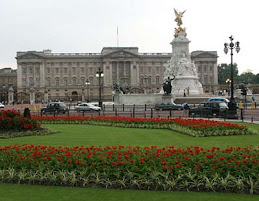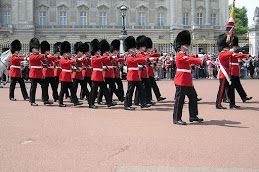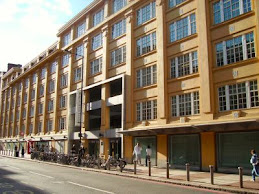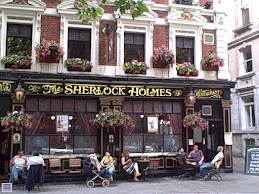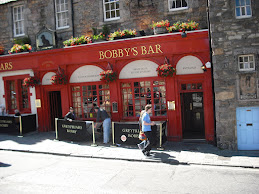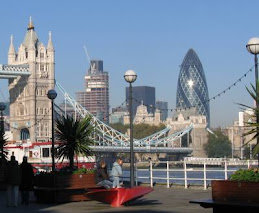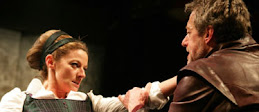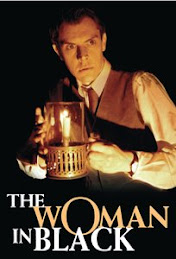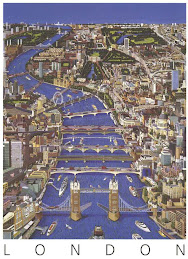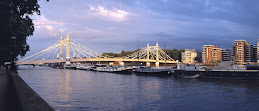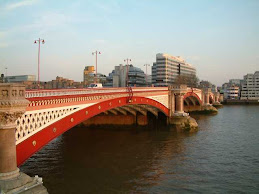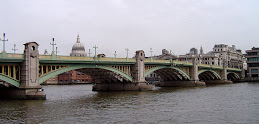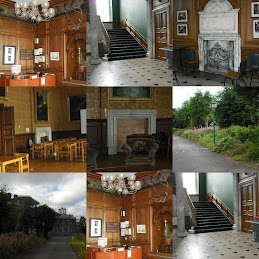To Shakespeare’s Birthplace We Go! Stratford-Upon Avon
A bus ride to Stratford-Upon-Avon was the best mode of transportation from London Central that brought the class to our places of interest for the day: Shakespeare Library and Archives & the Royal Shakespeare Theatre. Our tour guide was Clare Maffioli and her colleague Joane Wilding. The quaint town offered many beautiful houses and gardens. To list some of the historic, Tudor homes and buildings that I either visited later in the day or passed by as I strolled down the streets of town or travelled past was the family cottage of Shakespeare’s wife, Anne Hathaway, the childhood home of Shakespeare’s mother, Mary Arden, Nash’s House which is Shakespeare’s final home and also owned by his granddaughter Elizabeth, and the Harvard House museum of British Pewter, the Elizabethan home to Katherine Rogers who is the mother of John Harvard of which Harvard University is named. All of the houses and gardens come together beautifully in this town to tell a story of Shakespeare, as you try to imagine, see and hear his works come to life!
The Tour of Shakespeare Centre Library and Archive:
Putting Shakespeare into context, what better way to study the history of his works than by visiting the Shakespeare Centre Library and Archive, as our first stop for the day. The end of the day treat for our class will be to see the Shakespeare play, Taming of the Shrew at the Royal Shakespeare Theatre, in the evening prior to coming back home to London Central.
The Shakespeare Centre Library and Archive offers an array of Shakespearean resources, to include original materials that offer historical insight into 16th century Stratford. With official records dating back from the 12th century and papers that relay information about families in the local area, insight is given of the period in which Shakespeare lived. Of importance to this library is the offer of the United Kingdom’s rich source of Shakespeare plays, biographical information on his plays and historical accounts from the stage for examples. Also included in the collection are many books that patrons can preview from the reading room. Of value to this collection and to the patrons are video and sound recordings of all the plays. To access these recordings, patrons may set up an appointment for viewing. In addition to reviewing plays, poems, books, videos and sound recordings, patrons can do some genealogical research for the Stratford and surrounding regions at the Shakespeare Centre Library and Archive through access to original parish records, copy registers of Warwickshire villages, directories, electoral rolls and census returns. With a collection of thousands of images of Stratford to date, the collection offers patrons the ability to not only conduct research using important items, but to capture an image that helps to bring history to life. Shakespeare’s global reputation is well represented through the library collection and reveals the growth and development of the small town of Stratford-Upon-Avon into a international tourist dive. The full range of Shakespeare’s life and complete works are represented in the collection and the library services are free of charge. The Shakespeare and local collections includes the museum and educational department that offers services such as special educational programs for universities and schools. It was clear to me that this library offers a primary source of research information on the world renown cultural figure of Shakespeare.
Clare Moffioli introduced the group to the library, starting off in the reading room. We were then given an introduction to the cataloguing and research room. She told the class that the collection is segmented into two unique collections: (1) Local collection; and (2) Shakespeare collection. The local collection relates to Shakespeare’s local history and all about the places, people and events that tell many stories about where he lived. The Shakespeare collection offers insight into his time and works. An example of some of the items found in the local collection consist primarily of books and maps concerning Shakespeare. The Shakespeare collection offers the Royal Shakespearean Company (RSC) Archives of Shakespeare’s works and additional Shakespearean works. Included are critics and commentators of the plays themselves. The history of the performances, texts about lighting and props used every day, as well as programs, video and musicals copies are all represented in this collection that give patrons an insight into the daily Shakespearean performances. Clare let us know that this collection is of national and international interest.
WYKTKA-A What You Need To Know About the Archives:
From the reading room, the discussion lead to the archival books. Clare informed our class that most of the archives rest downstairs for conservational purposes and is considered the “strong room.” The temperature and humidity levels are very controlled for preservation purposes. Controls alert the staff to water levels. Archival materials are stored in archival quality. She also told us that copies of materials could be found upstairs (ie. Prop books) and that patrons are allowed to look at what the collection offers.
Miscellaneous Information and Library Statistics:
During a question and answer session of our class members and Clare, she let us know in relation to the availability of an electronic collection, that this library is so small a library that there are not any electronic catalogs made available at the time. Of interest, there are approximately 3,000 readers that use the collection each year. There are many people that access needed resources in the collection by email and phone reference requests to cap off at around 5,000 patrons per year.
Who are the Library Patrons? Popular Items Requested & Digital Image Archives too!
Interestingly, the majority of library patrons are the school children locally, which gives insight into the usage of the library collection and the local community in which Shakespeare lived and worked. Of popular interest to the patrons locally, nearby or at a distance for research, are directories of houses/residences and buildings, local genealogical records of birth and death (ie. where someone is buried) and the history of houses and their uses over time. Of very popular interest in the collection is obtaining information on Shakespeare performers, producers and histories, reviews, illustrations, portraits and videos to view how the performances were portrayed for some examples. Clare stated that in order to provide photos and prints, funding had to be generated to offer this service. While the library does not offer a digital collection of primary sources (ie. Books), Clare did inform us/show us the Archives Catalog. It is an image database that is user friendly and very searchable by projects of RSC performances. One can search by a title, character, date or other key words examples. In order for the library to offer such a service, the Librarians must obtain permission and request it from the publishers, actors or others. They are charged a product fee, but if they have the book then it is of course free!
Special Collections and the Online Catalogue:
In the past, Clare informed my class that local artwork offered distinctive and unique art work to include herbal paintings and oddities such as four-footed beasts and other creatures for just a few examples. The items are lumped into the special collections the library maintains. Items such as these can be located in the card catalogue that the library updates. There is an enormous index catalogue that offers the bibliographic information on each item up through the year 2000. It is clear to me that the online catalogue database available from the library website is fairly new. This tells me that possibly lack of funding, staffing or a large collection may be roadblocks to providing more access via the online catalogue, yet I was tremendously impressed with the amount of work that had been done, with the help of volunteers as well! All items in the collection after year 2000 can be accessed through the online catalogue. Help in this area is oftentimes charity run, with profits coming from the local historical houses and private grants to help with this major project.
Collection Development, General Library Services, Staff & Interlibrary Loans (ILL):
It was on this day that I learned the library seeks to continue developing the collection in the offer of foreign language texts, with a storehouse of some pre 17th century books on up to modern day items. The library employs twelve library staff members to include library assistants, library specialists and library volunteers who help out tremendously with the database/image catalogue and conservation each week. I was very surprised to hear that the volunteers were doing a bit of real library work, so I understand them to be extremely valued. There are some interlibrary loan services offered, where borrowing is agreed among similar libraries, institutions and colleges. When asked if there were any consortia agreements with other libraries to share collections, Clare mentioned COPACT.
For more information about the collection, Clare stated that the library offers approximately 50,000 books. Outreach is pretty extensive as the library is always seeking new opportunities to bring the collection and services to the people for educational and recreational purposes. Outreach is typically for school and university groups with literature programs coordinating with library.
Preview and Aim of the Broad Spectrum of Collections: The Folio’s
The Shakespeare Centre Library and Archive offers an expansive display of Shakespearean and local collections. Our Librarian tour guide let us know that the Shakespeare Birthplace Trust was formed in 1847 with aims to collect around Shakespeare. Items are saved for the nation by the trust and seek to further develop a relevant collection of Shakespeare’s lifeworks during his lifetime, along with his contemporaries. The collection offers a boastful collection of over 50,000 books and pamphlets, with many coming from the Royal Shakespeare Company and Memorial Theatre. Two of the collections the library offers are built around folios. The First Folio was published in 1623 by two of Shakespeare’s colleagues (“Kingsmen”) as a memorial to him after his death. This folio is very valuable as it is the closest to his original work/plays and had been printed upon a single sheet. Clare said that a Folio is printed on paper and placed into a folder of related works. A Quattro is similar and less expensive to compile. The first Folio was sold two years ago for a large sum of 2.1 million dollars. She also informed us that 750,000 copies have been printed. The number of copies that are known to have survived are 228 in number and have been bought by very wealthy individuals for the library. An interesting story on the side was told about Durham’s Folio, a wealthy individual who had bought one of these precious folios, and how it was famously stolen and showed up in Washington and appeared in many tabloids. The library currently houses 30 of Shakespeare’s folios and they are very valuable! One of the folios is on display near the birthplace/visitor center. Two of these folios have been purchased for the library by trusts. One of them is in good condition and others of theatres are facsimiles.
Royal Shakespeare Library: Other Special Items in the Collection
The Royal Shakespeare library has been in Stratford since 1964. The Shakespeare Centre Library and Archive has taken over the collection of administrative type records there, such as records, reviews, posters and photographs for example. Black and White as well as colorized photographs and slides of productions have been acquired, as well as video records that go back to the turn of the century.
I was not surprised to learn that local schools must study Shakespeare and perform drama, so they frequent the library to do a bit of research in preparation for their roles and the performances and to learn all about Shakespearean history.
Clare told us about the Play Bills, which are early posters of major Shakespeare productions. The library has an extensive collection of these posters from productions!
There is a special collection of approximately 800 books from around the year 1700 of minutes and herbalites. Clare said that there is a gap in what they understand about Shakespeare’s life during the time following the plays. They are not sure exactly which book sources he may have used himself. An example of an item/book in this special collection that the class was given a special opportunity to view is the play, A Midsummer’s Night Dream from 1619. Another is Herbals, an early medical book of Shakespeare that was published in 1597. According to Clare, Shakespeare was quite a naturalist and talked much about nature and health. There were some interesting spells and concoctions for ailments found in this book. One example is the use of thyme, yet he spelled it “time”. Shakespeare’s medical interests and influence in writing about medicine may have come from his son-in-law who was a physician.
The special collection also included three adaptations of A Midsummer Night’s Dream from the years 1661, 1692 and 1716. Another item from Shakespeare’s personal collection is a pocket atlas with original binding. A map with handcolors communicated the theatres and things such as the dress of the day and of the characters. There was an amazing black and white photograph of Richard Burton who starred in a Shakespeare play! I also previewed a poster from 1874 of the first production of the play, Much to do About Nothing. Of importance and value to me on this day, a special viewing of the first page of Shakespeare’s highly valued folio took place! We were told that there were most probably actual drawings of Shakespeare’s within and that the folio offered plays and not poetry. It was interesting to see that even though there were 36 title plays in the table of contents, only 35 were within and one was left out!?
The end of the tour was a visit to the book stacks with the oldest book being the folios dating back to 1579 and containing prints and pictures. Downstairs were more of the oversized items that had its own classification scheme. There were many boxes that held each item in the stacks, with some coming from the Victorian Theatre. We were told that items from current plays are kept in plastic boxes and house such things as Henry VI props. Lastly, the class viewed the numbered room with the video collections and red boxes for programs.
Helpful Websites:
Shakespeare Birthplace trust: Library and Archive
